Menu
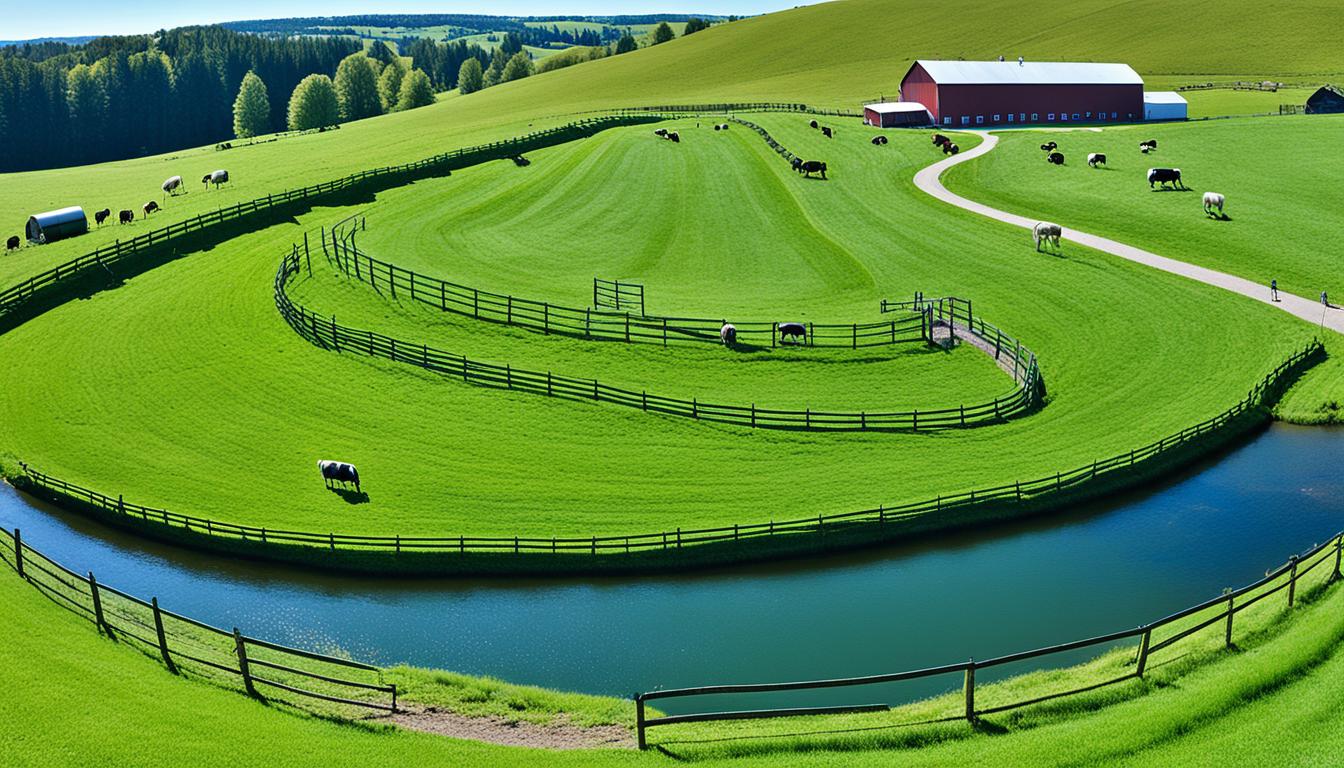
Mismanaged grazing can change grass type, causing preferred ones to vanish and weeds to take over. This shows how crucial pasture management is.
Good pasture systems boost plant growth and farm animal health. They help balance the food and animals to boost profit and pasture health. Managing grazing right helps grass recover, stopping weed growth.
Animals pick the best plants to eat, which can harm the field if not controlled. Defoliation plans based on science help fields recover well, keeping the right plants growing.
Leaving animals to graze randomly can lower field quality. But, with a smart grazing plan backed by knowledge, more animals can live on the same space. This method is proven to make farms more efficient.
Pasture management systems help make livestock farming profitable and eco-friendly. They use rotational grazing techniques and grassland maintenance strategies. This boosts grass health, increases food for animals, and cuts costs.
Good pasture care boosts farm earnings, helps nature, and keeps animals well. It’s vital to know how cattle grazing affects grass, weeds, and water. These are key parts of running a successful farm.
Well-kept grasslands are vital for keeping animals healthy and productive. Farmers must watch the fields closely. They need to get rid of harmful plants, respond to changing weather, and take care of the land. This can improve how water flows, the soil drains, and nutrients spread. It also reduces the need for bought food.
Having a grazing plan is key to looking after the land and using resources well. Changing how animals eat throughout the year helps keep the food they eat good quality. This tackles problems like weeds, soil health, and moisture, which vary with the seasons.
Spring and autumn are important for checking the soil’s health. This helps decide what food the land needs. Putting lime on the soil helps keep the grass healthy. In spring, getting rid of weeds and managing the food are crucial for a strong pasture.
There are different ways to manage how animals eat the grass, each with its own benefits and challenges. Rotational grazing is often the best approach. It means making sure there’s always enough grass. This keeps animals well-fed all year.
Modern tech, like satellite images and EOSDA Crop Monitoring, make looking after pastures easier from afar. They let farmers keep a close eye on how the land is doing. A well-kept field is not just good for animals. It also helps the environment by capturing carbon, making oxygen, saving the soil, and recycling nutrients.
Better pasture care means more food for animals and fewer costs on bought food. This boosts farm earnings. It also makes the farm more valuable and looks good, whether it’s in the country or near town.
In the end, using good grassland maintenance strategies and smart rotational grazing techniques is key to success. It helps farms, nature, and animals thrive together.
Using sustainable grazing helps keep the environment in balance. It’s not just good for the land and water, but also for the plants animals eat.
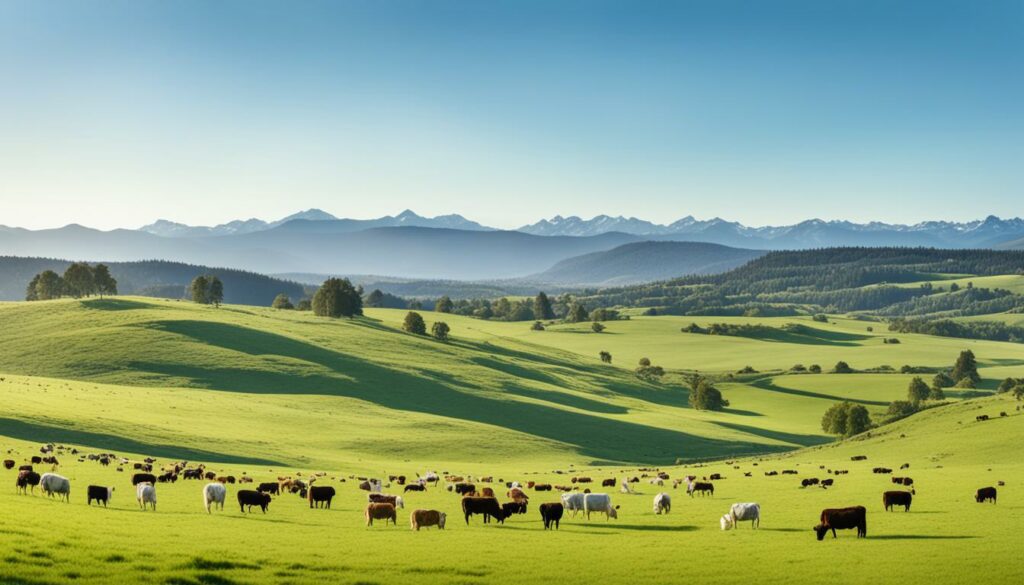
Sustainable grazing boosts soil health. It’s done through careful supervision and sampling of the feed. Methods like rotational grazing let the land recover. This way, more food grows for the animals. As a result, the land is used better, and farming costs less.
Proper grazing also helps keep water clean. It makes soil drain well and stops overgrazing. This protects the water we drink. Also, it keeps the environment balanced by saving natural carbon filters. This lowers the risk of floods and droughts too.
Good grazing reduces weeds without using extra feed. It makes the land better for both farmed animals and wild creatures. This way, the whole ecosystem is healthier. It’s like a natural way of maintaining the environment.
Rotational grazing improves pasture health and efficiency in a structured way. The land gets separated into smaller areas or paddocks. Animals move between these sections, making sure the land gets well-managed.
In this method, grasslands get enough time to rest. This is key for grass to grow back and stay healthy. Studies have proven that this system can boost the amount of food grown by 20%.
Keeping the grasslands in good shape is vital. Farmers in Wisconsin made more money per cow because of this method. It shows that taking good care of pastures is good for the wallet too.
When setting paddocks up, think about forage, animal size, and what you need for the animals. Intensive rotational grazing can produce and use more food on the same space than constant grazing. Done right, it ensures the land stays healthy while feeding the animals well.
Using fences costs money but it’s a good investment, from $30 to $70 per acre. The number of paddocks can vary a lot, but careful choice boosts food growth and longer grazing times.
Optimal grazing management aims to keep the right balance between what the pasture provides and what the animals need. This balance is key to keeping the pastures healthy and the animals productive. Using sustainable grazing and rotating forage crops helps use the pastures well and for a long time.
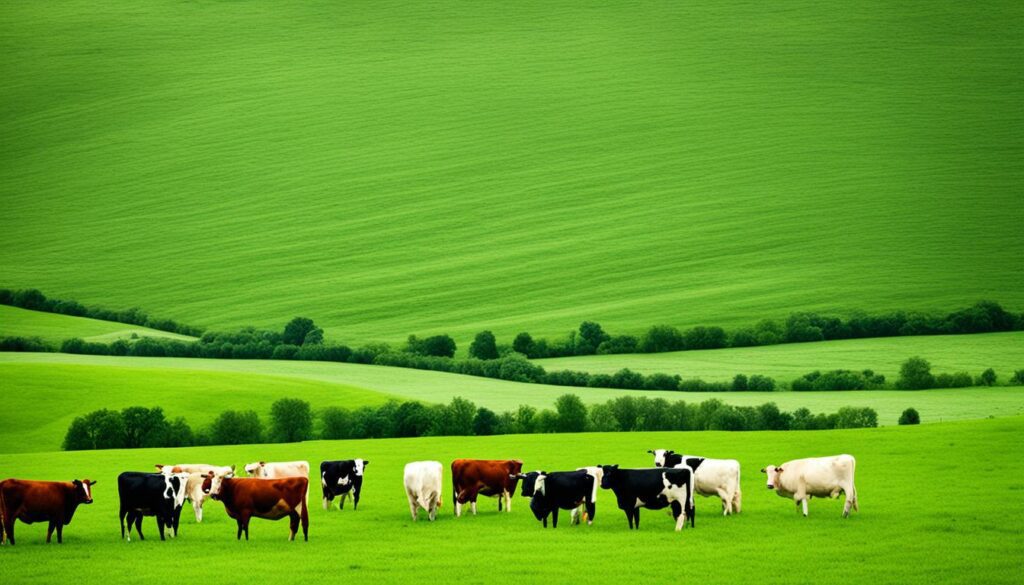
Finding the right amount of forage for the animals is important. It includes figuring out how many animals a field can support without eating too much. Animals need to graze at the right times to keep the plants healthy and full of nutrition. This way, farms can use their land without needing extra food for the animals.
Grazing in areas that were not useful before can add more grass for the animals. This helps lower the costs of producing cattle, since food is the biggest expense. So, proper grazing brings down costs and makes the most of the land.
Checking how the grass grows is crucial. This helps spot when the plants are about to flower, which means they’re less tasty for the animals. By knowing this, farmers can change how the animals graze. This makes sure there’s always good, fresh food for them.
Measuring the grass with tools like hula-hoops and squares is a good way to see how much food there is. This info helps decide when the fields need a break. Letting pastures rest makes for more food for the animals and a better supply overall.
Good pasture care helps the land, wildlife, and keeps grasslands healthy. With the right grazing and crop rotations, we can keep pastures healthy for a long time. This means the land works well, and the animals stay strong and healthy.
Using different forage crops can greatly improve the food available for animals. By planting diverse crops, we enhance the diet of livestock. This method also helps protect against pests and bad weather.
Adding different types of forage crops improves grazing. For example, summer crops like forage sorghum and millet grow well after small grains. This extends the season for feeding livestock. They grow best in warm soils, much like corn and soybeans.
Winter crops, including cereal rye, are great for feeding animals the following season. They provide cover for the soil. Using legumes like crimson clover also sustains high-quality nutrition. They can be grazed quickly in spring without losing too much crop.
Brassicas, such as kale and turnips, offer good protein but can lead to bloat if overeaten. Mixing many types of crops helps maintain a healthy environment. This reduces diseases while ensuring there’s plenty of food for animals all year.
Creating a good crop rotation plan involves picking the right crops. For example, oats grow fast and can be ready for grazing in a month. They are good for late fall or winter food.
It’s important to know about the soil, the seasons, and what the animals need to follow the plan. This means deciding on the best order and times to plant crops. By doing this, we can make sure there’s always good food for the animals.
In conclusion, planning crop rotations well improves the land, helps fight off pests, and provides varied, healthy food for animals. This is key to keeping our pastures healthy and our animals well fed.
Putting livestock in pasture systems is key for the best grazing management. By carefully picking what animals to use and managing how they eat, we boost how well our pastures work.
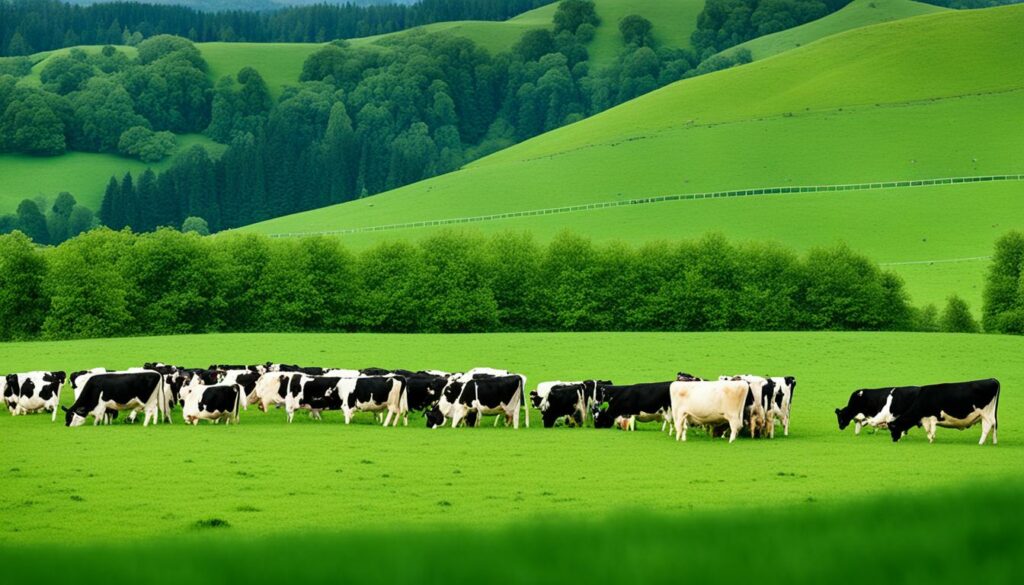
Picking the right animals is crucial for good pasture control. We need to choose the best types and breeds that fit our food and land. This choice should also meet animal needs and what people want to buy. By picking animals that are good with what’s around them, we use food well and lower costs. This also makes sure that not-so-good land is used well. It helps the animals and the land work together well.
How animals eat is important for the best pasture care and for the land to improve. Knowing how they eat and what they like helps us set up good ways for them to move around and eat. This stops them from eating too much in one place.
Rotating where animals graze can make the land produce more. It involves splitting the land into parts and moving the animals around in a careful way. This gives the land time to rest and grow back before the animals come back to eat there again. So, the land stays healthy and can keep feeding the animals well.
Using the right strategies for how animals eat makes sure we use the land well. We can figure out how much food the land can give by measuring the grass. It’s also about keeping an eye on the land and letting it rest enough. This way, we make sure there’s always enough food for the animals. And the land stays strong and healthy.
It’s crucial to manage pastures well for the Earth and for efficient grazing. We can boost soil, control forage quality, and lessen harm to nature by using smart strategies.
Starting with checking the pastures often is key. This helps us see if they’re getting worse and lets us step in early, like by mowing to stop weeds. Giving parts of the land a break helps plants recover and keeps the whole ecosystem healthy.
We must also work on making the soil better and more fertile. Benefits like saving money and helping the planet come with good pasture care:
| Advantage | Description |
|---|---|
| Reduces Labour Costs | Efficient management practices lower the amount of labour required for pasture upkeep. |
| Strengthens Soil Tilth | Improved soil structure supports root growth and nutrient uptake. |
| Reduces Erosion Risk | Healthy pastures with strong root systems are less prone to soil erosion. |
| Provides an Economical Feed Source | Well-maintained pastures reduce the need for additional feed inputs such as silage and hay. |
A good plan for managing pastures is really important. Knowing what we do well and not so well helps us use our resources smarter. Grassland care plans for each season are a helpful guide for staying productive all year:
Using tools like the EOSDA Crop Monitoring platform can make a big difference in how well we look after pastures. With satellites, we can watch how the land is doing and plan grazing times better, making our grazing more effective.
To sum up, looking after grasslands well means combining eco-friendly methods with new tech. This way, we keep them productive and in harmony with nature for the long haul.
Managing soil fertility in pastures well is key to good grazing. Testing the soil regularly shows what nutrients are there and what’s lacking. This helps create a plan to fix imbalances, boosting soil and growing more forage.
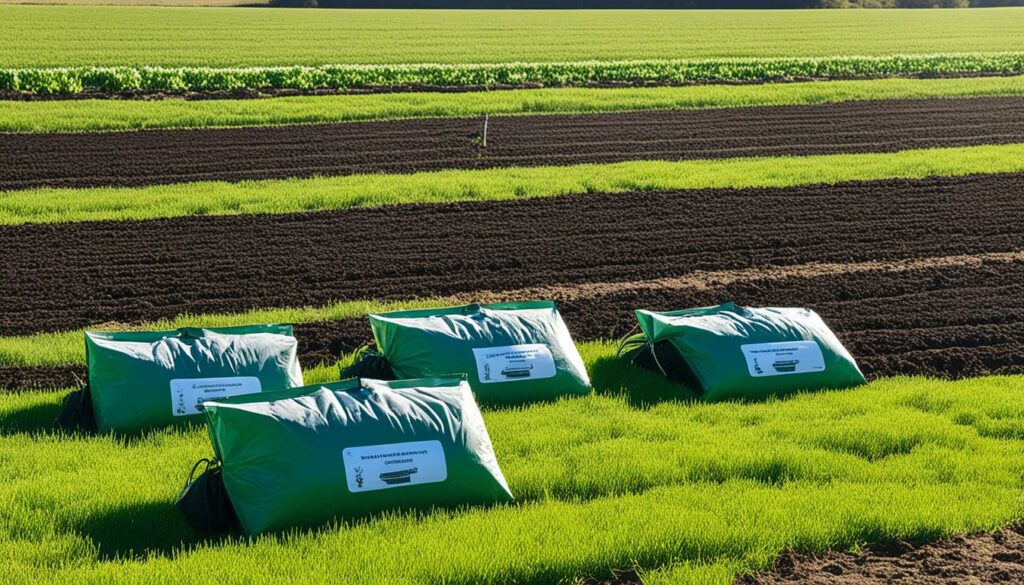
To sample, we take about 20 soil cores 0 to 6 inches deep. Checking pH, aiming for 6.5 or above, is vital for forages like clover and alfalfa. We test in spring and fall to pick the right fertilisers for each season.
Organic and inorganic fertilisers are both important for soil health. Organic matter from composting or manure boosts soil life and plant roots. Inorganic fertilisers supply immediate nutrients needed for strong growth and big forage yields.
| Nutrient | Organic Sources | Inorganic Sources |
|---|---|---|
| Nitrogen (N) | Compost, Manure | Urea, Ammonium Nitrate |
| Phosphorus (P) | Bone Meal, Rock Phosphate | Superphosphate |
| Potassium (K) | Wood Ash, Compost | Potash, Muriate of Potash |
An effective soil fertility management blend uses both organic and inorganic ways. This supports good forage growth and overall pasture health. These methods are the basis for sustainable grazing practices and help keep livestock healthy and productive.
Keeping grazing areas productive and healthy is vital. This involves using various methods. Each method aims to make the grass more dense, increase plant variety, and raise the overall quality of the pasture. Let’s look into how to improve pastures effectively.
To boost the density of forage and stop soil erosion, overseeding and reseeding are key. By carefully managing grazing, the grass eaten by animals can be more nutritious than stored hay or silage. This is because fresh grazing happens often and losses during harvesting or storage are rare. It’s important to maintain the height of grass, particularly for cool-season plants like perennial ryegrass and meadow brome. They do best when not too short, between 2 to 5 inches high. Overseeding helps fill any gaps in the pasture, improving overall land management.
Another crucial step is managing pests and weeds. It’s important to regularly check for unwanted plants and pests. Using livestock in a smart way can help control weeds and pests, keeping the pasture’s forage in top condition. The careful use of herbicides and other tools is also significant. It’s been noted that a 1,000 lb cow might eat around 24 lb of dry matter each day. So, maintaining excellent pasture health is key for the well-being of livestock and their productivity.
By checking pasture conditions and using these methods, we can keep our pastures healthy and productive in the long run. These actions are part of a broader strategy for maintaining grasslands.
It’s key to make grazing systems more efficient to help animals thrive and make the most of their food. By using rotational grazing techniques, the pasture’s quality and amount can get better. Studies show cows eat about 24 lbs of dry matter each day, with most of their time spent grazing. These methods give the grass enough time to recover, which keeps it nutritious.
When managing cool-season grasses, the right grass height is vital. For instance, avoid grazing perennial ryegrass under 2 inches or timothy too low. This care keeps the plants healthy and productive for longer.
Rotational grazing techniques can boost how much livestock can produce. For example, in Georgia, using rotational stocking led to 37% more calves. This system also helps keep the land healthy, avoiding problems like overgrazing. This is good for the soil and doesn’t reduce the quality of the food the animals eat.
Using optimal grazing management means feeding animals in a way that makes the most of what the land grows. Forage efficiency can go up to 80% with careful grazing planning, much higher than the 30-40% from letting animals graze everywhere at once.
To do this, you need to keep a close eye on what’s happening in the fields. Things like how much of the land the animals use, how many animals are in an area, and how well the animals are doing can tell us a lot. This information helps us adjust our grazing to what the land can offer, making our animals and farms better.
“The key to successful pasture-based livestock enterprises lies in harmonious and adaptive grazing management,” experts affirm.
By using smart rotational grazing and making sure there’s always enough food, we can improve how well our farms work. This approach gives us better food for the animals and keeps everything in good shape.
Continuous grazing systems let animals roam freely on pasture all year. It makes managing livestock easier but has downsides. These include uneven use of land and the risk of overgrazing. A detailed guide is key to tackle these problems.
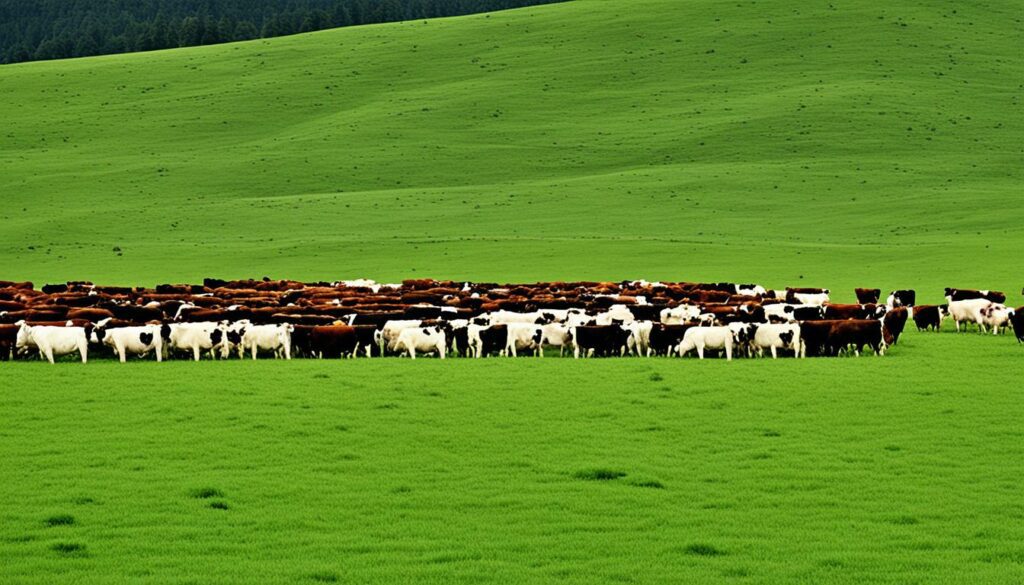
To run continuous grazing systems well, correct stocking rates are vital. Too many animals can damage the pasture, which hurts productivity. So, it’s important to match the number of animals to the land they have. This avoids overgrazing and keeps the pasture healthy.
To ensure grazing is even, using certain tactics is a must. For example, putting water and minerals in various spots can spread out where animals graze. This stops any one area from being overused while others are left untouched.
Evaluating pastures regularly is essential for an efficient grazing system. Checking the forage quality and amount helps you act quickly to keep the pasture healthy. This early help makes sure problems are fixed before they get big.
It’s good to know that continuous grazing isn’t as efficient as rotation. Rotating animals from patch to patch can up forage by 30-50% and let you keep more animals. But, continuous grazing is still vital in some places. It’s chosen when simplicity and less work are the main goals.
| Grazing System | Forage Quality | Stocking Rates | Management Complexity |
|---|---|---|---|
| Continuous | Lower | Moderate | Simple |
| Rotational | Higher | Higher | Complex |
Balance is key for making choices about grazing systems. Knowing the pros and cons helps make the best decision for your farm. With the right knowledge, you can manage pastures better. This leads to more efficient and profitable livestock farms.
Intensive rotational grazing is a big step from old ways. It breaks large pastures into small areas. Animals move between these areas, eating in a way that helps the land.
This modern way of grazing brings many good things. It makes more food for animals by 30-50% than the old way. By moving animals a lot, it stops the land from being overeaten.
The land gets time to rest and food stays good. We can also keep more animals and waste is spread out evenly. This makes the soil richer for better plants.
“Intensive rotational grazing is substantially more productive than continuous grazing, with 30-50% higher forage production per acre.”
To do this kind of grazing, you need to plan well and set things up first. You must make sure animals have enough to drink and the fields are fenced. It’s also important to look at the fields closely to know when to let the animals in.
There are tricks like using hula hoops to guess how much food there is. This helps know the right number of animals for each area. Keeping an eye on the land and adding the right things to it keeps the system going strong.
Doing all of this means the farm stays good for a long time.
| Grazing System | Forage Production | Infrastructure Cost | Stocking Rates |
|---|---|---|---|
| Continuous Grazing | Lower | Lower | Lower |
| Intensive Rotational Grazing | 30-50% Higher | Higher | Higher |
Good pasture management helps our pastures stay healthy and productive all year. We must know when and how different forages grow best. This knowledge keeps our pastures in good condition.
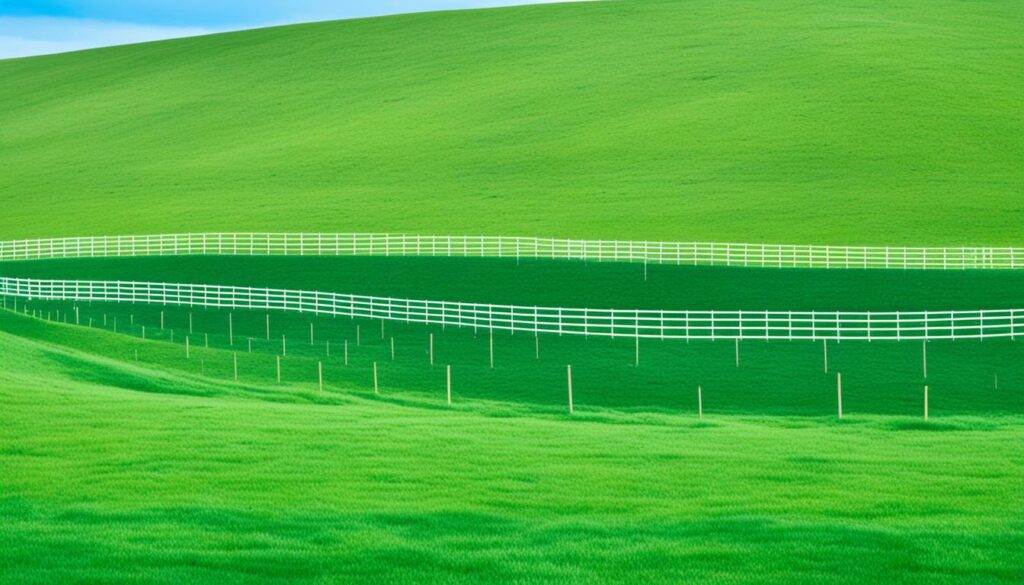
In winter, we make plans for grazing and mark out lands. We get ready for the seasons with more activity. In spring, we work on soil and nutrients, control weeds and forages, and set up grazing fields. This helps us use our land well.
Summer is about checking the fields and deciding when to fertilise. We keep an eye on the grass and make changes as needed. This way, we use our grass well by planning carefully.
Autumn is for planting new seed and adding lime and nitrogen to the soil. Cool-season grasses grow well now. They like the cooler weather and moisture. These steps get the fields ready for winter and the next year.
Looking after the fields every season does a lot of good. It boosts forage, keeps the soil and water clean, and fights off weeds. Doing things at the right time, like fertilising, controlling where animals graze, and changing crops, helps a lot. It keeps our pastures healthy over time, which is good for the animals who eat from them.
In today’s fast, changing agricultural scene, technology is changing how we care for pastures. Tools like pasture management software and remote sensing help us better take care of pastures. They give us important information that boosts productivity and keeps pastures sustainable.
Using software makes managing grazing areas easier. For example, pasture.io‘s Pio app uses AI to help make smart choices on grazing and more. By looking at soil, weather, and suggesting best animal diets, it boosts pasture and livestock health.
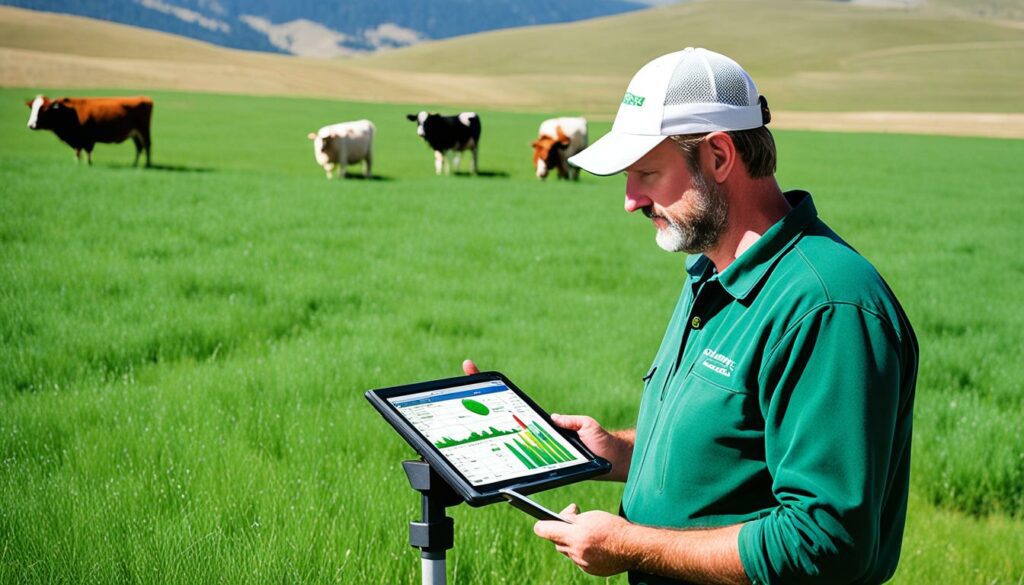
Satellites and remote sensing help us watch over pastures better. They take detailed pictures and give farmers a look at plant health. With tools like Rangeland Analysis and Grass-Cast, farmers can predict how well plants will grow. This info lets them adjust grazing and resources carefully.
These technologies can highlight where pastures need help, preventing overuse. This not only makes pastures more productive but also boosts farming’s income potential.
| Technology | Functionality | Impact |
|---|---|---|
| Pasture Management Software | AI-driven soil analysis, weather prediction, diet optimisation | Increased pasture and livestock productivity, reduced costs |
| Remote Sensing | High-resolution satellite imagery, vegetation health monitoring | Improved grazing management, timely interventions |
| Satellite Technology | RAP and Grass-Cast data analysis | Enhanced resource allocation, strengthened ecosystem sustainability |
So, combining pasture improvement methods with these tech tools really works. It helps farmers run more sustainable and successful livestock farms.
Grazing and defoliation plans should help forage grow well and keep animals fed. It’s key to cut the grass just right to keep pastures lush. This boosts the amount and goodness of the forage.
In winter, plants don’t grow, so grazing doesn’t harm them much. But, if animals walk too much on the grass, it can harm the buds. Grazing just enough can help by letting in more sunlight. This stimulates the growth.
It’s crucial not to let animals eat on very wet ground. This can flatten the soil and make it erode easily. How often animals eat a certain area matters too. They need time to eat, rest, and grow back strong. Overdoing it leaves too much dead stuff.
Checking how much leaf area animals eat is vital. Taking too much harms the plant’s ability to grow back. Different plants can handle munching better than others. For example:
Making sure animals spread evenly is very important. Setting up water sources matters a lot too. It helps animals feed in a balanced way, making the grassland more productive.
Knowing about past grazing, the types of plants, and soil affects how well the forage grows. Looking at past stocking rates in similar places can help decide how many animals to put in. Even spreading the animals over the land supports healthy grazing over time.
In conclusion, getting the pasture management right is a big deal for running livestock smoothly. In this article, we’ve looked into how to make grazing better. We talked about rotating where the animals graze, studying how they act, and using new tech. These methods mean we get good food for our animals, keep our land healthy, and our water clean. This helps us make money and look after the planet.
Research tells us that swapping where animals eat is better than letting them eat everything in one area. This rotation helps the plants grow back stronger, so there’s more food for the animals. “Rotational Grazing on Rangelands” shows this clearly. It says that moving animals around makes the land healthier and the food better for them. By keeping the grass in the right stage of growth, we make sure animals get all the nutrients they need every day.
Also, know the type of animals you have and what they like to eat. This lets us pick the best way for them to graze. The right way not only makes the food better but also keeps the land in good shape for longer. As we learn more about grazing, we must keep changing and learning. This way, we can make the most of our fields. And our livestock will stay healthy and our land protected for a long time.
Pasture management cares for livestock and the environment. It aims to make farming profitable while keeping the soil and surroundings healthy. These methods include looking after the grass, producing enough food, and cutting costs.
Good grazing helps the soil by improving plant health. It also balances the ecosystem. Healthy pastures drain better, support more good bacteria, and grow better food for animals. This helps the soil stay fertile.
Rotational grazing splits land into areas for animals to move between. This allows each area to rest and grow fresh, high-quality food. It follows the natural growth cycles of plants.
To keep enough food available for animals, farmers check how much the grass grows. They make sure animals eat at the best times. Such care keeps the plants healthy and tasty for the animals.
Rotating different plants helps the soil and fights diseases. It also makes sure there’s always good food for animals. This mix means animals eat well and the land stays healthy all year.
Picking the best animals means looking at what the land can grow and what the animals need. It’s a careful choice to make sure the farm runs well.
Checking the fields, cutting on time, giving them breaks, and improving the soil are all key. These steps make sure the land stays good for a long time and helps more plants and animals live there.
Keeping soil rich means testing it, adding things like compost, and using the right fertilisers. This makes the land grow more food and keeps it healthy.
Making the land better includes planting more variety, keeping pests and weeds away, and using plans that fit the land’s needs. This makes the fields healthier and more productive.
By using timed rotations, farms can control how much and when animals eat. Measuring how well the land gets used and how the animals do also helps make better choices.
In a continuous system, animals can eat from the fields whenever they want. This makes it easy to manage but can wear the fields down if not planned well. Checking on the fields often helps prevent problems.
This method provides more and better food for animals and spreads out where they go. It improves the land and how the whole farm works. It needs good plans and some investment but makes the farm better overall.
To keep the land in good condition all year, farmers should do different things each season. Winter maps the land, spring checks the soil, summer looks at grazing, and autumn plants new food. This keeps the land healthy and growing all the time.
Today, there are apps, sensors, and satellites that help farmers look after their land and animals better. These new technologies check on the fields, plan eating areas, and make sure everything is used well. They’re a big help in making the farm work smoothly.
It’s about picking the right times for animals to eat, making sure they spread out, and giving them enough but not too much food. This way, the food grows back strong, and the land stays in great shape.